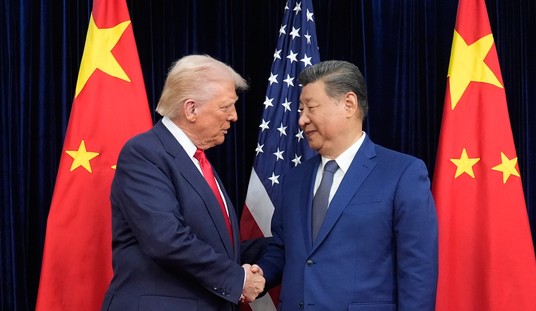The backers of the bailouts to General Motors cried with triumph this week when the automaker announced that they had repaid their bailout loans ahead of schedule. That amounted to proof of the wisdom of government intervention, the argument went, and wondered aloud why bailout critics didn’t acknowledge their errors. Perhaps it’s because the government essentially got paid off with even more government money:
During an April 20 hearing on Capital Hill, Sen. Tom Carper, (D-Del.) asked some pointed questions of Neil Barofsky, the “special watch dog” on the Wall Street Bailout, aka, TARP.
“It’s good news in that they’re reducing their debt,” Barofsky said of the accelerated GM payments, “but they’re doing it by taking other available TARP money.”…
“It sounds like it’s kind of like taking money out of one pocket and putting in the other,” said Carper, who got a nod of agreement from Barofsky.
“The way that payment is going to be made is by drawing down on an equity facility of other TARP money.”
This prompted a stern letter from Senator Charles Grassley (R-IA), who backed the bailouts, to Treasury Secretary Tim Geithner about the shell game being played by the Obama administration and GM (via Yid with Lid, emphases mine):
General Motors (GM) yesterday announced that it repaid its TARP loans. I am concerned, however, that this announcement is not what it seems. In fact, it appears to be nothing more than an elaborate TARP money shuffle.
On Tuesday of this week, Mr. Neil Barofsky, the Special Inspector General for TARP, testified before the Senate Finance Committee. During his testimony Mr. Barofsky addressed GM’s recent debt repayment activity, and stated that the funds GM is using to repay its TARP debt are not coming from GM earnings.
Instead, GM seems to be using TARP funds from an escrow account at Treasury to make the debt repayments. The most recent quarterly report from the Office of the Special Inspector General for TARP says “The source of funds for these quarterly [debt] payments will be other TARP funds currently held in an escrow account.” See, Office of the Special Inspector General for TARP, Quarterly Report to Congress dated April 20, 2010, page 115.
Furthermore, Exhibit 99.1 of the Form 8K filed by GM with the SEC on November 16, 2009, seems to confirm that the source of funds for GM’s debt repayments was a multi-billion dollar escrow account at Treasury—not from earnings. In the 8K filing GM acknowledged:
- Of the $42.6 billion in cash and marketable securities available to GM as of September, 30, 2009, $17.4 billion came from an escrow account with Treasury,
- $6.7 billion of the escrow account available to GM was allocable to the repayment of loans to Treasury,
- $5.6 billion in cash would remain in the Treasury escrow account following the repayment by GM of their loans, and
- Upon repaying Treasury, any balance of escrow funds would be released to GM.
Therefore, it is unclear how GM and the Administration could have accurately announced yesterday that GM repaid its TARP loans in any meaningful way. In reality, it looks like GM merely used one source of TARP funds to repay another. The taxpayers are still on the hook, and whether TARP funds are ultimately recovered depends entirely on the government’s ability to sell GM stock in the future. Treasury has merely exchanged a legal right to repayment for an uncertain hope of sharing in the future growth of GM. A debt-for-equity swap is not a repayment.
I am also troubled by the timing of this latest maneuver. According to Mr. Barofsky, Treasury had supervisory authority over GM’s use of these TARP escrow funds. Since GM’s exit from bankruptcy court, Treasury had approved the use of the escrow funds for costs such as GM’s obligations to its parts supplier Delphi. See, Office of the Special Inspector General for TARP, Additional Insight on Use of Troubled Asset Relief Program Fund (SIGTARP-10-004), dated December 10, 2009, at page 6. According to the GM 8K, GM had planned to use the TARP funds in escrow to pay back the TARP loans on a quarterly basis beginning in the fourth quarter of 2009. But following the April 20, 2010, hearing of the Senate Finance Committee, where Treasury’s decision to exempt GM from the bank TARP excise tax was questioned and GM’s refusal to testify was noted, it is odd that GM suddenly drew down on the TARP escrow and accelerated the repayment of the remaining balance of GM’s outstanding TARP loans.
The bottom line seems to be that the TARP loans were “repaid” with other TARP funds in a Treasury escrow account. The TARP loans were not repaid from money GM is earning selling cars, as GM and the Administration have claimed in their speeches, press releases and television commercials. When these criticisms were put to GM’s Vice Chairman Stephen Girsky in a television interview yesterday, he admitted that the criticisms were valid:
Question: Are you just paying the government back with government money?
Mr. Girsky: Well listen, that is in effect true, but a year ago nobody thought we’d be able to pay this back.
Mr. Girsky then said that GM originally planned to pay the loan over the next five years. So the question is why—other than a desire to justify excluding GM from the administration’s TARP tax proposal—would Treasury and GM reduce GM’s TARP debt with TARP equity and then mischaracterize it as a repayment from earnings? Accordingly, please explain:
1) Your department’s justification for allowing GM to use funds from the TARP escrow account to repay TARP loans,
2) The amount of funds remaining in the TARP escrow account at Treasury that may be released to GM, and
3) The date that you anticipate that the remaining funds in escrow will be released to GM.
Thank you in advance for your cooperation. Please provide the requested information by April 30, 2010. …
Sincerely,
Charles E. Grassley
Ranking Member
In other words, this is just a shell game. As Jim Vicevich points out, it’s akin to paying off your Visa credit card with your Mastercard — and then bragging about your financial condition. Taxpayers are still on the hook for GM. Nothing at all has changed.
Instead, we have another good reason for government to refrain from bailing out private companies. It makes them act like government when it comes to transparency about their finances. This claim really does prove that GM now stands for Government Motors.








Join the conversation as a VIP Member